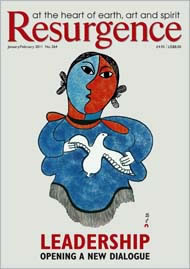Soul and spirit: two intangibles so hard to define that they are often muddled. In a book which should rightfully be called A Guide to Soul and Spirit, Patrick Harpur has searched history, mythology, anthropology, philosophy and literature for help in giving form to these most subtle of bodies. And we are in sore need of understanding this basic duality, for both our world and we ourselves suffer from inner division. Soul and spirit are estranged.
At first this book reads like a compendium of all that has been written on the subject – a quick overview – but gradually Harpur’s magic begins to work and you find yourself, as always with this extraordinary author, at the feet of a master. He has order and imagination in perfect balance: having had a vision or insight, he can set it out with rational clarity. He is like a mathematician with words.
At first we are guided through territory so well-known it barely requires a guide. That’s his way. He lures you in and from the familiar takes you to the unfamiliar, making it easy to understand in his step-by-step exposition, and by the end of the journey we discover we’ve crossed a treacherous bog in which many a theologian or philosopher has perished.
“Spirit is expressed in metaphors of ascent, height and light… Soul is expressed in metaphors of descent, depth and darkness.” Spirit seeks God; soul embraces Death. They do not get along, these two, especially in that toxic mixture of Protestantism and secularism which is the Western mind.
Spirit is a puritan, an ascetic disciplinarian. He resents soul: “her images and urges, memories and fears, farts and fits of giggles are always breaking in on his high-minded, solemn meditations”. Spirit is concerned with truth; soul with beauty.
It is perhaps the work of this age, and of every person in this age, to truly be individual in the literal sense: that is, undivided. For these personifications of soul and spirit do not relate to anything other than to ourselves. If my creativity is blocked, it is my spirit doing it, criticising all my efforts until no further efforts may be made. If my meditations are agitated, my soul is behind it, saying “Boring! Boring! Let us dream!” The work is to integrate the self, to harmonise these apparent opposites for, as Harpur says, soul/spirit is the fundamental duality behind all dualities: male/female, yin/yang, east/west, etc.
“A wholesome life, it seems, is made out of holding spirit and soul together, in tandem and tension.”
It is in holding such dualities together, to believe in ‘both’ rather than ‘either/or’, that an oscillation sets up. As the two wings of the bird work together, the bird itself is still. And from that oscillation a third entity becomes apparent: the observer self who simply watches it all play out.
“The self is what spirit spends a lifetime searching for, heroically setting out by land and sea to circumnavigate the globe, to suffer hardship and slay dragons, until he comes to the remote overgrown castle. He hacks a way through, climbs to the top of the tallest tower, and there, the love his life, Beauty, lies sleeping. He kisses her. She wakes… Her waking symbolizes the soul’s dormant state till spirit wakes her, and makes her real. What is less obvious in our heroic age is that the kiss also wakes spirit. He looks around him, rubbing his eyes, and sees that the castle is in fact his castle, the place he started from. Beauty always slept there, but he did not notice her, so eager was he to set out and find her elsewhere.
“As soul comes to herself in spirit, so spirit returns to himself in soul – and they are joined in the holy matrimony of the self.”
Sometimes one has a sudden suspicion that Harpur is Mercury himself, our very own psychopomp, masquerading as a West Country writer, solitary and self-effacing, not to be known except through his work. I shall be referring back to this book repeatedly, to drink its wisdom and simply enjoy Harpur’s lyrical prose. It deserves a place in everybody’s library, nestling between scripture and literature, linking and harmonising both, marrying one to the other.
For more information visit: www.lindaproud.com







